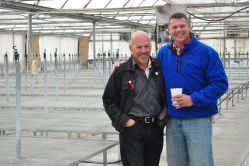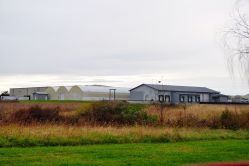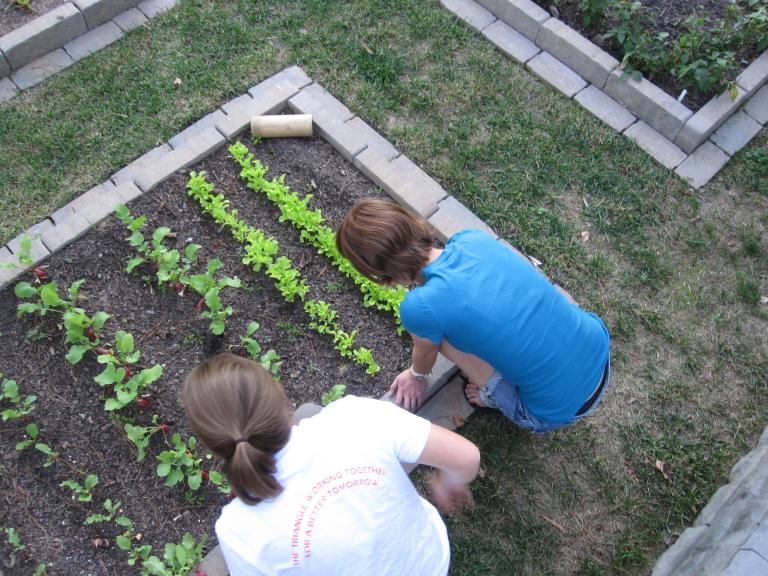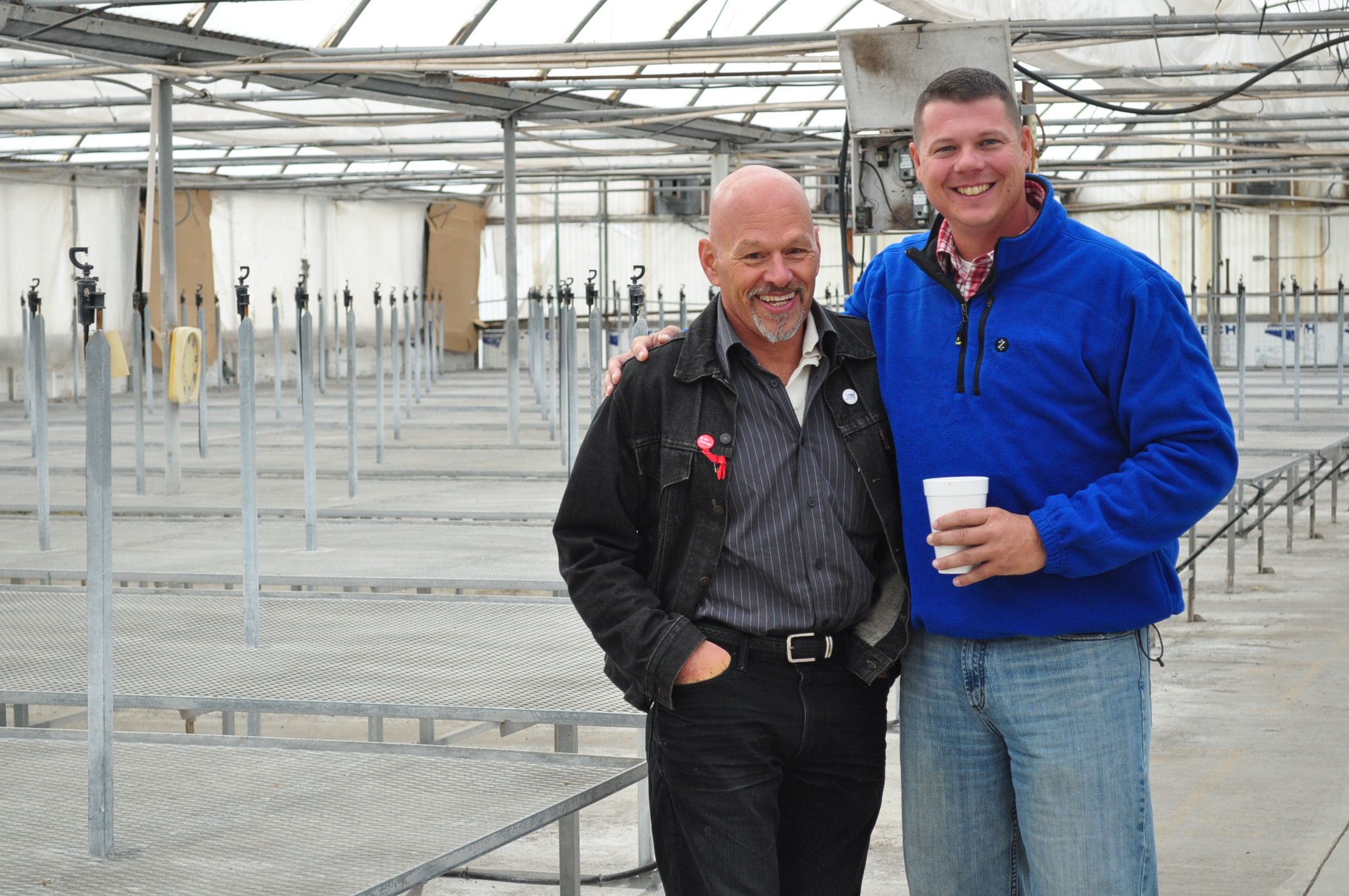
Whitney PipkinJim Epstein (left) and Mark Seale in one of the new Blue Ridge Produce greenhouses.
The maze of greenhouses, warehouses, and office spaces that is home to the Elkwood, Va.-based Blue Ridge Produce could have been custom-built for the company’s unique vision: to aggregate, process, grow, and promote local produce. But it wasn’t. In fact, the company’s founders lucked into finding an existing facility sprawled across 33 acres of land just south of the D.C. suburbs.
Blue Ridge Produce threw open the doors to its giant warehouse this growing season to welcome produce from across Virginia, only to have it quickly disseminated to wholesale buyers like Whole Foods and the University of Virginia in nearby Charlottesville.
The company also plans to lease 80,000 square feet of greenhouses to farmers who will grow tomatoes and lettuce year-round. Meanwhile, an extra warehouse will serve as a commercial kitchen for making jam, salsa, or other value-added products out of local produce. And the office spaces? Those will be a business incubator for food-oriented companies just getting off the ground.
Jim Epstein, a food-minded real estate developer, founded Blue Ridge Produce with the owner of a small retail market in Charlottesville, Mark Seale, after stumbling upon a common vision — and this facility. Together, the two men hope to create a food hub much like the many that have sprouted up around the country to help the local food industry scale up in recent years. The difference, however, is that Epstein and Seale are hoping to make a profit.
And the fact that this model is being seen as an investment opportunity says something about the stability, inevitability, and urgency of the local food market.

Many food hubs serve as the marketing and distributing arms for growers wanting to break into the larger-scale markets of nearby cities. And many are nonprofits (including Charlottesville’s Local Food Hub). They are often built from the growers up, establishing their own distribution streams that run parallel to the mainstream food system and include deliveries to individual restaurants or homes. But Epstein and Seale want to work within the existing channels, recruiting Sysco and Aramark to add local produce to their D.C.-bound truckloads, while aggregating food directly from farmers.
James Barham, an agricultural economist with the U.S. Department of Agriculture’s marketing service, who has visited the facility twice, says Blue Ridge’s laser-tight focus on aggregation is unique.
“They can really complement and add value to the traditional distribution system … and focus on [helping] producers building capacity to meet demand.” And, he adds, “Oh boy, do they have the space for it.”
More produce
Seale’s son-of-a-farmer finesse helped him convince growers who had long sold poultry or dairy to commodity markets that they could sell locally the produce they had begun to grow on the side. For the last several decades, a large swath of Virginia’s farm country has been in large-scale meat and dairy production, but Blue Ridge Produce is creating an incentive — and market — for more of those farmers to grow and sell fruits and vegetables. This effort could help chip away at the shortage of produce grown stateside (we don’t grow anywhere near enough for every American to eat their daily recommended three servings) and reduce the quantity of produce shipped from California.
But like other efforts to scale up of the local food movement, Blue Ridge has seen its share of complexity. While it may be Virginia-grown, most of the produce isn’t organic — at least not yet. But Seale is encouraging the farms he works with to transition acreage to organic over time. And while the company’s website says it will “strive to source from organic, local and low-spray producers,” it’s unclear when this will occur.
But organic or not, a switch to produce can be good for farmers. A study of farms in Virginia’s Culpepper County found that locally sold produce earned up to $3,000 per acre versus the $250 per acre earned in the commodity grain or feed crops that have traditionally been grown in the area.
“Some of our farmers put additional acreage into produce this season, because they knew we’d be there to sell it,” Seale says.
The 40 or so farmers who sold through Blue Ridge this past year were mostly small- to mid-sized operations, ranging from one to 2,000 acres in production. Many said they like working with a business that aims to make both of them more money in the process.
“I think there’s an attitudinal difference between for-profit and nonprofit,” Epstein said. “Our growers want us to make money, to be financially stable.”
Market demands
After seeing the demand for local food grow over the last several years, Epstein and Seale worked with investors and D.C.’s food-conscious crowd to raise $1.3 million in about four months in late 2010. They purchased the facility in time for last spring’s growing season and quickly got farmers and buyers on board, completing their first full season this year.
While many of the small-scale farmers that populate the growing regions in Virginia sell their wares at D.C. farmers markets, you won’t find much of their produce in the grocery stores. And they just can’t grow enough to meet the needs of such institutional buyers, like hospitals, schools, and universities.
Epstein conducted a feasibility study [PDF] on the local market in the fall of 2010, confirming his hunch that these bigger buyers want — and need — more local produce to satisfy customers. Students at the University of Virginia, for example, had begun boycotting dining facilities on the Charlottesville campus for not serving more of the local food that is now prevalent in nearby restaurants.
The local produce that D.C. restaurateurs like Nora Pouillon of Restaurant Nora first began demanding a quarter-century ago has trickled through farmers markets but has hit a distributing bottleneck. And farmers won’t grow more food until there is more infrastructure to bridge production and demand.
Despite the efforts of companies like Whole Foods and Chipotle to source directly from individual farmers, more than 99 percent of agricultural products in the U.S. were still being bought and sold through wholesale markets in 2010.
At the same time, Epstein and Seale’s feasibility study found nearly $17 billion being spent each year on fruits and vegetables in the tri-state area surrounding and including D.C. — with less than 7 percent of that produce grown in the region. If Blue Ridge Produce could “move that needle” just 1 percent toward local, it would max out the company’s facility at $100 million worth of produce, Epstein says.
Blue Ridge Produce is working to add more than aggregation to the on-site menu as they respond to emerging demands in the market.
The company is interviewing farmers and cooks now who could take up shop in the greenhouses and commercial kitchen spaces, growing some veggies year-round while creating products out of others to help address one of the biggest obstacles facing an all-local food system here: the off-season.
But all this is secondary to growing what they started this past year — a business that brings a bit of certainty and some higher wages to farmers who rarely have both.
“Jim and I, we don’t want our local product to be a cheap one,” says Seale, who’s set up the business as a benefit corporation focused on the farmers. “We have the ability to show Virginia growers that farmers can be profitable for years and years to come.”




